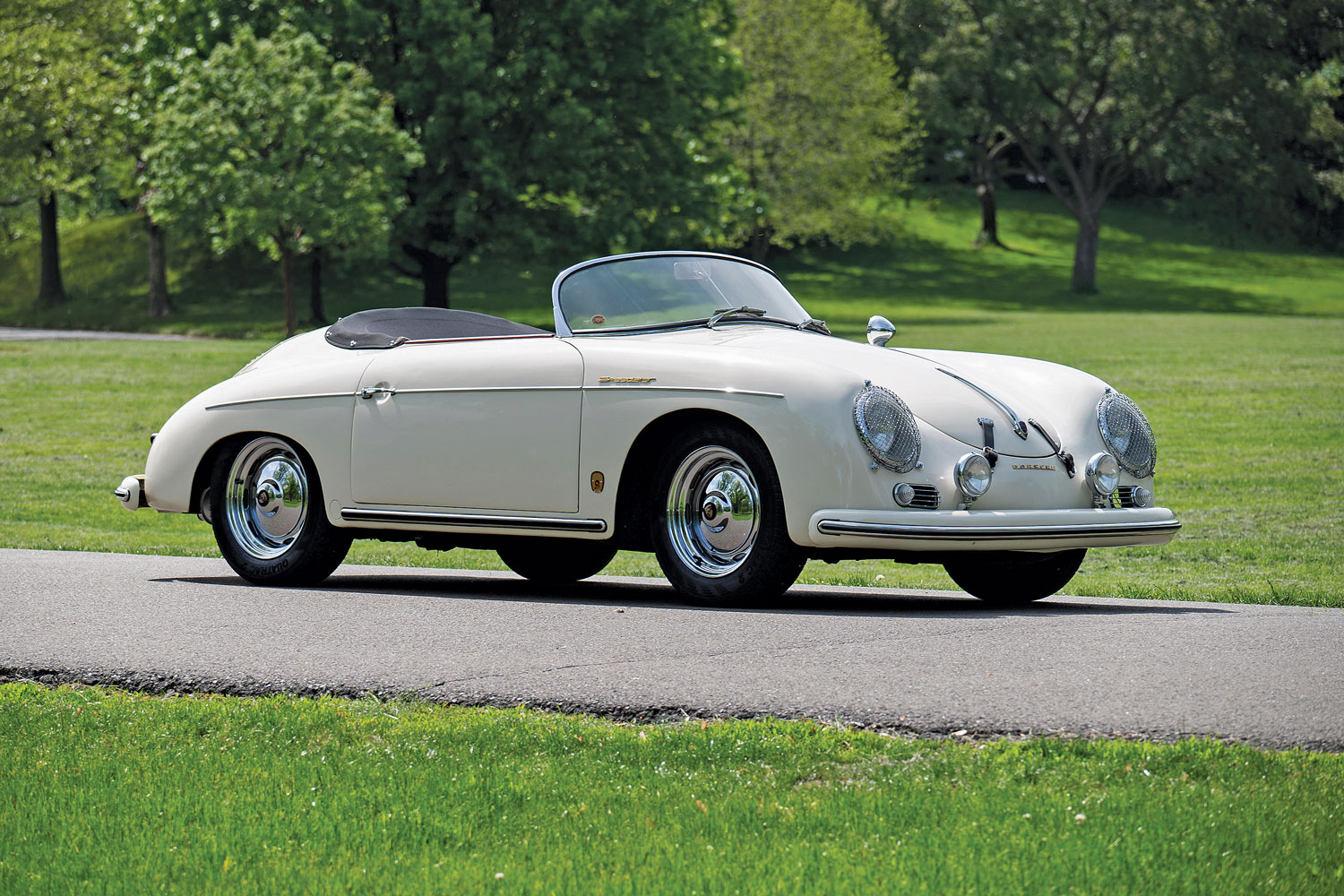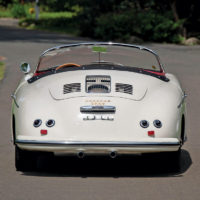SCM Analysis
Detailing
| Vehicle: | 1957 Porsche 356A Speedster |
| Years Produced: | 1954–59 |
| Number Produced: | 4,145 |
| SCM Valuation: | $326,500 |
| Tune Up Cost: | $1,200 |
| Chassis Number Location: | Aluminum tag in crevice between gas tank and passenger’s side inner fender; stamping on metal crossmember below gas tank; aluminum tag on A-pillar |
| Engine Number Location: | Base of generator stand, facing rear |
| Club Info: | Porsche Club of America |
| Website: | http://www.pca.org |
| Alternatives: | 1959–69 Austin-Healey 100-6, 1955–57 Triumph TR3, 1955–62 MGA roadster |
| Investment Grade: | B |
This car, Lot 140, sold for $285,500, including buyer’s premium, at Bonhams’ Greenwich, CT, auction on June 5, 2022.
I have detailed the history of the 356 Speedster before (see German Profile, November 2020). But we should still start with a brief recap: Max Hoffman, the U.S. distributor, persuaded Porsche to develop the Speedster because he wanted a low-cost roadster to compete with Triumph, MG and Austin Healey.
The car was based loosely on a previous Hoffman request, the $4,600 aluminum-bodied 1952 America Roadster, of which just 16 were built. Hoffman wanted a $2,995 target price, which he got for a while. He made the tachometer and spare tire optional, although you couldn’t buy a Speedster without them. Wags joked that the passenger’s seat and heater boxes would be next.
A racing stalwart
The Speedster was appealing, with its low profile and rakish windshield. As a road car, it was a success primarily in warm-weather areas, as its side curtains and loose-fitting top were far from weatherproof. At 170 pounds less than a coupe, its low weight gave it an advantageous power-to-weight ratio.
The car became a favorite of racing enthusiasts. While Speedsters would out-sprint coupes in acceleration tests, times were close. Speedsters were not as aerodynamic (9.5% less with the top up, 16.2% less with top down, per a report in the January 1956 Road & Track), which is why you saw them racing without windshields and with tonneau covers fitted. In that guise, their weight advantage won out. In Europe, however, the cars sold poorly, and they didn’t catch on for competition. Hillclimbs were ascendant there and coupes were preferred.
Medium rare
Porsche built 4,145 Speedsters across six model years. The 1954–55s were the last of the 356s that were somewhat VW-based, and usually are less desired today. Starting with the 1956 models, the 356A introduced many changes for the better. Engines grew to 1,582 cc (vs. 1,488), and gearboxes and suspension were also improved. Production was 200 in 1954, 1,134 in 1955, 1,056 in 1956, 1,170 in 1957, 552 in 1958 and 33 in 1959. (The ’59s were primarily racing 4-cam Carrera Speedsters.) By comparison, Porsche built 4,232 1959–62 Convertible Ds and roadsters and 14,345 1950–65 all-weather cabriolets.
The Speedster was not an instant collectible — it took a while to become an icon. In the late 1960s you could buy solid ones for $1,500. I did — then I paid $1,900 for a 1963 cabriolet. Afterward, values trended upward, mostly with inflation.
What to look for
About a decade ago, I did an exhaustive research article for Porsche Panorama (published in the January 2013 issue). At that time, Speedster values ranged from $160k to $205k for “usable as-is, with plastic filler” cars, $180k–$225k for a “solid no-issues driver,” and $215k–$265k for an “excellent/local concours-quality car.” National-level concours cars, of which there are few, doubled those top values. Speedsters peaked in 2017, although the best examples are still $500k–$700k.
As usual, condition is the prime consideration in price, especially since 356s are prone to rust. A common deal killer is the use of thick plastic filler to repair rust, patch up a wreck, or just contour the curvaceous 356 body. A rusty Speedster project should be worth the value of the restored car minus the cost to restore it — plus a stipend for the owner’s time and anguish. In my experience, that should be about $175,000. That said, projects almost always sell for too much money, and leave owners underwater.
Then comes matching numbers and colors per the Kardex (a factory build card for warranty tracking) or Certificate of Authenticity. On Speedsters, the doors, rear lid and hood are coded to the serial number. The “as-built” engine and gearbox numbers are on the CoA and Kardex. I recommend a 20% ding for a mismatched engine, 5% for a gearbox, and 10% to 20% for exterior paint and interior colors — ameliorated when the incorrect ones are period-accurate and more popular or attractive.
Engine choice is the third major consideration. Normal Speedsters have 60 horsepower in a 1,582-cc 356A vs. Super models with 75 hp. (In 1,488-cc Pre-As those numbers are 50 and 70, respectively.) Super Speedsters are rarer, especially on earlier model years, and are worth at least 10% more.
Because there are so many reproduction parts available, next comes originality of exterior and interior metal trim, instruments, upholstery materials, and engine-compartment equipment. Last are the intangible market and taste choices. Some people prefer the beehive quad taillights of Speedsters through the T1 356A (March 1957 changeover to T2), while some prefer the later teardrops. Others, especially Americans, prefer the U.S.-market chromed tube bumper overriders, while Europeans gravitate towards the plain unadorned bumpers.
Restored racer
Our subject car was a well-raced example that had been restored for street use. Sold new in Germany, the car’s next recorded history is in the early 1960s as an SCCA race car. The car continued to race into the late 1960s or early 1970s. Along the way it adopted and lost a 4-cam Carrera engine (while other Carrera bits remained). In 1996 — seven owners later — the consignor acquired the car.
Reflecting its heritage, the car was far from stock. It had a 1960 Super 90 engine carrying Weber 40 IDFs, a Type 741 gearbox with BAE3C hillclimb gears, and the old jellybean limited-slip differential with a 6:33 ring and pinion. It also kept its louvered rear decklid from its Carrera days. The interior was in red but with non-matching black seats.
We have no information as to bodywork (or filler), but it would be unusual for any Speedster raced for that length of time to not have some bumps and bangs. On the other hand, the car presented well with headlight grilles, side spears, incorrect chrome 5.5-inch wheels with Super hubcaps, and the louvered rear lid. If the body was solid, the $285,500 paid was a good deal for a non-original Speedster that can nonetheless provide a lot of driving enjoyment. ♦
(Introductory description courtesy of Bonhams.)




